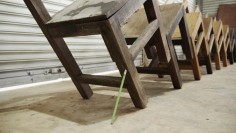Makha Sanewong
Not stand. Not Fall

source: makhatumblr
We rarely give a thought to mass-produced everyday objects, especially when they have been in use for a long time, and many would consider them worthless compared to a treasured asset or artefact in a collection. But in their very functionality, they point much more directly to the relationship between owner and object. Then there is their symbolic or iconic dimension, which may be quite independent of this individual relationship: for example, a pair of scales inevitably carries notions of accuracy and justice, of probity in commerce, of exact measurable value. Each object has a powerful fixed identity and an emotional and ideological charge.
Our understanding of the meaning and function of any object is formed early; we mostly learn in childhood what an object does,how to feel about it, and what to expect of it. But experiences peculiar to a person or group can also freight it with new meaning, as when lightbulbs and ladders combine to produce seemingly unreasonable fears, when our heart skips a beat at the sight of a bicycle, or when airport police go on high alert over an unaccompanied suitcase.
My experiences and memories give me a sense of how groups or individuals behave. Some of these are rational, but many are not. In this exhibition, I am trying to show how my own experience has sometimes painfully transformed and transfigured everyday objects.
Choosing these objects and giving their functionality a slight nudge so their meaning becomes precarious raises the question whether the object is still the same we once knew so well. If you’re standing in front of an object you’ve known all of your life but it doesn’t behave according to the function or meaning you normally attribute to it—what does that do to your own place in your environment?
.
.
.
.
.
.
source: vimeo
Makha Senewong Na Ayuthaya is New wave of artists who live and work in Bangkok. He graduated BFA. Sculpture at Faculty of Painting Sculpture and Graphic Art from Silpakorn University in 2008. After graduated he has been involved in Art Fields with doing art and several exhibition at Art Gallery. In early He interesting in mechanical of tools that we can see form every days life, By applied and challenge them become a Kinetic Sculpture or unfamiliar objects in differences function. To present a private story that he has felt form their objects. As now Makha still doing Art in Multiple Science and Art Media. He play around and question the things to find out ,”What is the things around us ?”
.
.
.
.
.
.
.
source: wtfbangkok
Makha Sanewong na Ayuthaya is fascinated by everyday objects, their functionality and our dynamic perceptions of them. Simple objects to him are elaborate representational systems—what William Empson called “compacted doctrines”—that embody our beliefs about such things as creativity, form and function. Yet his work is not about form, or in any straightforward sense about the beauty of the quotidian: not for him the gorgeous shining contours of Duchamp’s urinal, the silkscreen prints of soup cans.
Instead, he focuses on the mundane and humble: rigidly rectangular school chairs and desks that perhaps embody an unattainable ideal of uniform education, tin weighing scales used in wholesale/retail shops. These objects allow him to reflect on the processes that shape our perceptions and by which representation mediates them to generate our sense of what the object is, where it fits into our hierarchy of things, and so on.
An old-fashioned angle-poise lamp, such as might have lit the desk where you did your homework, still burns but lies unplugged on the floor, coiled in something like defeat, shining its light on nothing; a pair of equally weighted scales rise and fall according to no discernible principle; a rank-and-file of chairs teeters at an alarming angle, seemingly propped up only by a pencil…
On one level, Makha follows the time-honoured tradition of taking an object and defamiliarizing it to generate a kind of error message in the mind, to potentially comic effect. With at least half an eye on the political tribulations in Thailand, his installations depict the logical fallacies of positions whose underpinning has largely been stripped away: if you can’t sit on a chair, what good is it? Why did it ever need to be the shape it is?
His work thus points to the upheavals that arise when new realities clash with our perceptions and pre-perceptions—in other words, with our fervent hope that the world will still be tomorrow what we believe it to be today.
But by the same token it has a thwarted nostalgic quality. Many of these objects, which have been familiar to most Thais since childhood—scuffed, dented, worn with use—have been superseded by sharper, more cost-effective devices and are turning up in scrapyards. To find them alarmingly manipulated, reintegrated, recontextualized and reconfigured is to experience them in some ways afresh, but in others to see them through a melancholy, scratched, sepia-tinted screen. And in that sense his work harks back to an even older artistic tradition concerned with memory and its pains, and with the insistent reminder that “this too shall pass”.
Makha is part of a new wave of Bangkok artists. He graduated with a BFA in sculpture from the Faculty of Painting, Sculpture and Graphic Art at Silpakorn University in 2008. His works have been shown in several galleries and museums in- and outside Bangkok, including the eminently respectable 56th National Exhibition of Art at the Bangkok Art and Culture Centre in 2010, a group show, and a solo exhibition entitled “Non Still Life” at Pongnoi Community Art Space in Chiang Mai in 2011.

